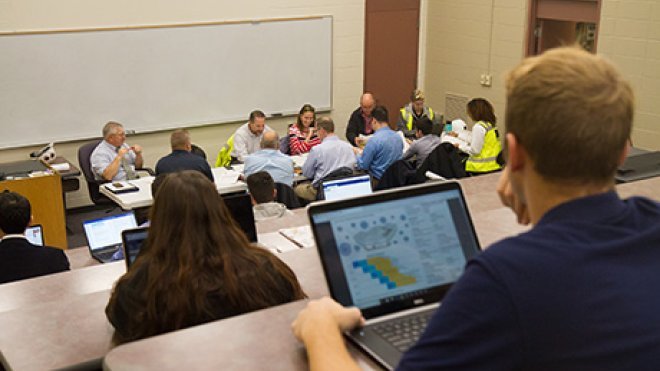Making SECCM Labs Construction Meetings Part of the Course
Construction management students learn the process of a major construction project directly from the builders and project owners

BRISTOL, R.I. – What was that concern about road clearance that came up between the Roger Williams University project managers and the building contractor about the SECCM Labs construction project, asked Lauren Glancy.
A temporary road leading to the project site “isn’t wide enough for the fire department,” answered Rob Jones, her classmate in the construction management course. “They were saying it should be 20 feet but it’s not that wide.”
To help the students understand why the Fire Marshal has raised this issue, Professor Gokhan Celik explained that fire departments require enough space to bring in trucks and access water in case of an emergency during structural construction projects.
While it’s not uncommon for classroom discussions like theirs to weave in real-world examples of what’s being studied, the students in this course boast the advantage of witnessing firsthand a large-scale construction project as it unfolds and analyzing the entire process from behind the scenes.
That’s because Roger Williams University and Shawmut Design & Construction are partnering to make the SECCM Labs project a “living laboratory” where all students in the School of Engineering, Computing, and Construction Management (SECCM) are observing and learning each step of the project directly from RWU’s Capital Projects staff, builders, engineers, and designers.
Like many SECCM faculty members, Professor Celik integrated the construction project happening at their doorstep into the curriculum for his courses. Each week, the students in his Construction Project Management and Safety course attend the SECCM Labs construction meetings about the status of building permits, site safety, soil testing and more, then head back to their classroom to explore the aspects of a major construction project from the perspectives of the contractor and the owner.
“Was there anything interesting or surprising from today’s meeting?” Celik asked his students. “Have you realized anything about the project you hadn’t realized before attending the meeting?”
Brian Santoro noted that the status of funding kept coming up. That’s a great example that ties in with their recent classroom discussion about the funding ability of a project, Celik said
“Contractors have concerns about whether there’s enough money to finish a project,” said Celik, adding that it impacts the contractor’s ability to keep to the project schedule and plan ahead. “That’s why you shouldn’t shy away from asking about funding for the project.”
When Celik asked why the construction partners were holding a separate meeting that week on “MEP” (mechanical, electrical, and plumbing) coordination, several students knew the importance of planning ahead for that stage.
They’ll bring all the subcontractors together “to look at clashes in the model and if plans will interfere with each other,” Jones answered.
And it helps the main contractor “schedule who’s on site at what time to coordinate the work,” Nick Morrison added.
“Yes, if you go to one of these meetings” – and the students had been welcomed to join that as well – “you’ll recognize how tight that work is,” Celik said. “There’s a ton of systems crossing each other, and it’s impossible that these subcontractors can work independently of each other. This is a time they can all look at the plans and address problems before work begins.”
Being able to observe the contractors review plans or hear a project manager and architect problem-solve an issue and then take those lessons back to the classroom has been invaluable for Jones.
“We get to see real-world construction and apply it to our classes. We’re getting to see it being built in front of our eyes and learn how these meetings take place and what they talk about. That’s pretty valuable to us as students,” Jones said. “This experience will make us stand out [to employers and graduate schools] because not every student gets an opportunity like this.”